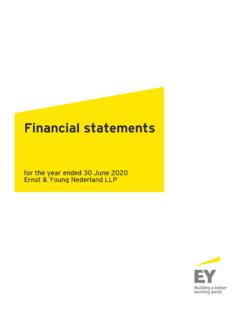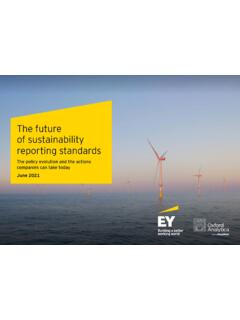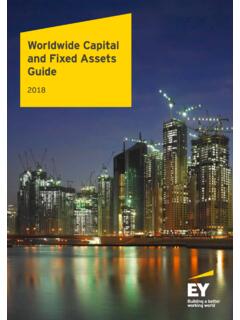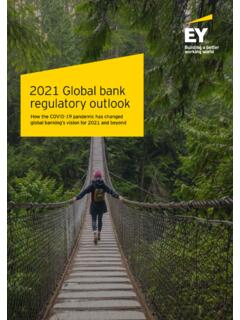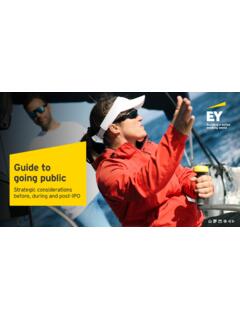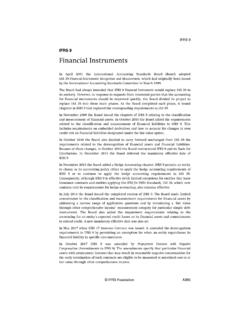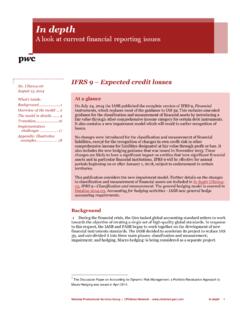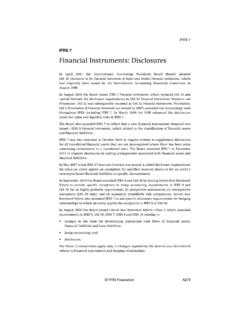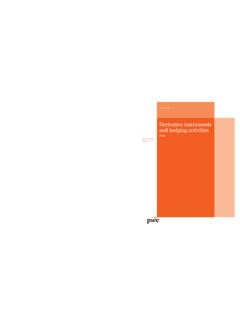Transcription of Hedge accounting under IFRS 9 - EY
1 Hedge accounting under IFRS 9 February 2014 Applying IFRS February 2014 Hedge accounting under IFRS 9 1 Contents 1. Introduction 2 The main changes in the IFRS 9 Hedge accounting requirements 3 2 Risk management 4 Object of Hedge accounting 4 Risk management strategy versus risk management objective 4 3. Hedge items 6 General requirements 6 Hedges of exposures affecting other comprehensive income 6 Aggregated exposures 7 Risk component 10 Components of a nominal amount 15 Groups of items 18 Credit risk exposures 26 4. Hedging Instruments 27 5 Qualifying criteria 30 Designation 30 Economic relationship 31 Impact of credit risk 32 Setting the Hedge ratio 35 Designating proxy hedges 37 6. Subsequent assessment of effectiveness, rebalancing and discontinuation 39 Assessment of effectiveness 39 Rebalancing 40 Discontinuation 44 Measuring ineffectiveness 49 7.
2 Other changes from IAS 39 51 Time value of options 51 Forward element of forward contracts and foreign currency basis spread of financial instruments 56 Own use contracts 57 8 Presentation 60 Cash flow hedges 60 Fair value hedges 61 Hedges of groups of items 61 9 Disclosures 62 Background and general requirements 62 Risk management strategy 62 The amount, timing and uncertainty of future cash flows 64 The effects of Hedge accounting on the financial position and performance 66 10 Effective data and transition 68 Effective date 68 Prospective application in general 68 Limited retrospective application 68 2 February 2014 Hedge accounting under IFRS 9 1. Introduction On 19 November 2013 the International accounting Standards Board (IASB) issued a new version of IFRS 9 Financial Instruments ( Hedge accounting and amendments to IFRS 9, IFRS 7 and IAS 39) (IFRS 9 ( 2013 )), which primarily introduces the new Hedge accounting requirements.
3 IFRS 9 ( 2013 ) does not provide any particular solutions specifically tailored to so-called macro Hedge accounting , the term used to describe the more complex risk management practices used by entities such as banks. An accounting model specifically for macro hedging is being developed as a separate standard and a discussion paper on this subject is due to be published in the first quarter of 2014. The high-level aim of the new Hedge accounting model is to provide useful information about risk management activities that use financial instruments, with the effect that financial reporting will reflect more accurately how an entity manages its risk and the extent to which hedging mitigates those risks. Specifically, the new model aims to provide a better link between an entity s risk management strategy, the rationale for hedging and the impact of hedging on the financial statements. Snapshot of the most significant areas of change for Hedge accounting : Requirement High-level summary of key changes Hedge effectiveness testing This is prospective only and can be qualitative, depending on the complexity of the Hedge .
4 The 80-125% range is replaced by an objectives-based test that focuses on the economic relationship between the hedged item and the hedging instrument, and the effect of credit risk on that economic relationship. Risk component This may be designated as the hedged item, not only for financial items, but also for non-financial items, provided the risk component is separately identifiable and reliably measureable. Costs of hedging The time value of an option, the forward element of a forward contract and any foreign currency basis spread can be excluded from the designation of a financial instrument as the hedging instrument and accounted for as costs of hedging. This means that, instead of the fair value changes of these elements affecting profit or loss like a trading instrument, these amounts get allocated to profit or loss similar to transaction costs (which can include basis adjustments), while fair value changes are temporarily recognised in other comprehensive income (OCI).
5 Groups of items More designations of groups of items as the hedged item are possible, including layer designations and some net positions. Disclosures These are more extensive and require the provision of more meaningful information and insights. The new Hedge accounting model aims to provide a better link between an entity s risk management strategy, the rationale for hedging and the impact of hedging on the financial statements. February 2014 Hedge accounting under IFRS 9 3 The addition of the new Hedge accounting requirements mean that, for the first time, the application of IFRS 9 will be a serious consideration for non-financial entities. For many of them, Hedge accounting will be the most significant effect of the reform of the accounting for financial instruments. In particular, non-financial entities will have an incentive to apply IFRS 9 ( 2013 ) before the IASB completes its phase on impairment because the IASB then intends to create a consolidated version of IFRS 9 that will reduce the early application choices for different parts of the standard.
6 Applying IFRS 9 ( 2013 ), before it is superseded by a consolidated version, would enable Hedge accounting to be applied whilst deferring the application of the impairment requirements until the mandatory effective Based on previous IASB discussions, once the new consolidated version of IFRS 9 has replaced IFRS 9 ( 2013 ), entities may be left with no choice but to early apply the Hedge accounting and impairment requirements (and the revised classification and measurement requirements) all at the same time. To gauge the benefits of the new requirements, non-financial entities will need to consider their hedging activities and existing Hedge accounting , or why Hedge accounting has not been achieved in the past. This assessment encompasses operational aspects (such as the Hedge effectiveness test) as well as the eligibility of items (such as risk components of non-financial items) that can be designated in hedging relationships. For financial entities, the situation is more complex: the ongoing development of the limited amendments to the classification and measurement of financial instruments, as well as the projects on accounting for macro hedging and insurance contracts, create more uncertainty about the eventual picture and how the different projects will interact.
7 In this publication, we have taken a closer look at the new requirements, consider some of the potential benefits for reporting entities and also explore some of the challenges posed by them. We expect the insights in this publication to be particularly relevant for accountants, treasurers and all who are involved in hedging activities in both financial and non-financial services entities. The main changes in the IFRS 9 Hedge accounting requirements Hedge accounting under IAS 39 Financial Instruments: Recognition and Measurement is often criticised as being complex and rules-based, thus, ultimately not reflecting an entity s risk management activities. Consequently, the objective of IFRS 9 is to reflect the effect of an entity s risk management activities in the financial statements. This includes replacing some of the arbitrary rules by more principle-based requirements and allowing more hedging instruments and hedged items to qualify for Hedge accounting .
8 Overall, this should result in more risk management strategies qualifying for Hedge accounting . Some of the basics of Hedge accounting do not change as a result of IFRS 9. There are still three types of hedging relationships: Fair value hedges Cash flow hedges Hedges of net investments in foreign operations 1 In February 2014, the IASB tentatively decided that the mandatory effective date for IFRS 9 will be for annual periods beginning on or after 1 January 2018. Applying IFRS 9 ( 2013 ), before it is superseded by a consolidated version, would enable Hedge accounting to be applied whilst deferring the application of the impairment requirements until the mandatory effective date. 4 February 2014 Hedge accounting under IFRS 9 Hedge accounting remains optional and can only be applied to hedging relationships that meet the qualifying criteria (see sections 3, 4 and 5). IFRS 9 does not revisit the mechanics for hedges of net investments in foreign operations.
9 Such hedges must still be accounted for similar to cash flow hedges. IFRS 9 did have some consequential amendments to IFRIC 16 Hedges of a Net Investment in a Foreign Operation. Rather than providing a comprehensive summary of Hedge accounting , this publication focuses on the differences between Hedge accounting under IAS 39 and the Hedge accounting requirements in IFRS 9. 2. Risk management Objective of Hedge accounting Every entity is exposed to business risks from its daily operations. Many of those risks have an impact on the cash flows or the value of assets and liabilities, and therefore, ultimately affect profit or loss. In order to manage these risk exposures, companies often enter into derivative contracts (or, less commonly, other financial instruments) to Hedge them. Hedging can, therefore, be seen as a risk management activity in order to change an entity s risk profile. Applying the normal IFRS accounting requirements to those risk management activities can then result in accounting mismatches, when the gains or losses on a hedging instrument are not recognised in the same period(s) and/or in the same place in the financial statements as gains or losses on the hedged exposure.
10 The idea of Hedge accounting is to reduce this mismatch by changing either the measurement or (in the case of certain firm commitments) recognition of the hedged exposure, or the accounting for the hedging instrument. Although the Hedge accounting requirements in IAS 39 resolve many of the above-mentioned accounting mismatches, they do not accommodate some risk management activities that are commonly applied in practice. Furthermore, some of the requirements in IAS 39 are arguably arbitrary, such as the 80%-125% effectiveness requirement, and may lead to economic risk management activities not or no longer qualifying for Hedge accounting . As a result, the financial statements of many entities do not necessarily reflect what is done for risk management purposes, which is unhelpful for preparers and users alike. The IASB took this as the cornerstone of its project for a new Hedge accounting model. Consequently, the objective of the Hedge accounting requirements brought by IFRS 9 is to represent, in the financial statements, the effect of an entity s risk management activities.
